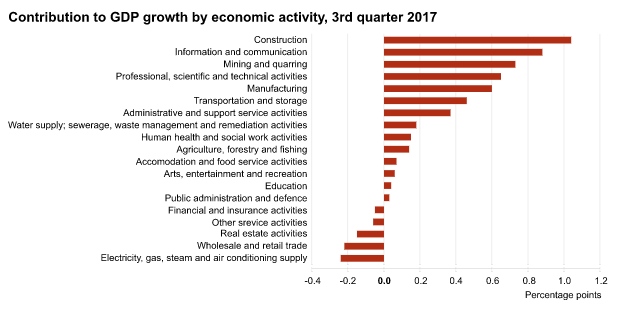Analytics, Economics, Estonia, GDP, Investments, Markets and Companies
International Internet Magazine. Baltic States news & analytics
Monday, 22.12.2025, 18:59
The economy in Estonia grew by 4.2% in Q3
 Print version
Print versionIn the 3rd quarter, the GDP at current prices was 5.8
billion euros. The seasonally and working-day adjusted GDP stayed at the same
level compared to the 2nd quarter of 2017 (growth 0.3%) but grew by 4.2%
compared to the 3rd quarter of 2016.
As in the previous quarter, the biggest contributor to
GDP growth was construction, which grew rapidly for the third consecutive
quarter. Other main contributors to GDP growth were information and
communication, mining and quarrying, professional, scientific and technical
activities, manufacturing, transportation and storage and administrative and
support service activities, which have previously shown rapid growth. The
biggest increase in value added continued to occur in mining and quarrying.

The main hindrance to economic growth was energy due
to a fall in its value added. Although the value added of energy grew at
current prices, an increase in prices in electricity, gas, steam and air
conditioning supply had a negative impact in real terms. Also trade, real
estate activities and other unspecified service activities and financial
intermediation had a negative impact in real terms.
Although net taxes on products increased at currents
prices, the GDP growth was slowed down by the net taxes on products at real
prices. The VAT receipts increased but excise tax receipts declined compared to
the same period of the previous year.
The exports of goods and services in the 3rd quarter
of 2017 stayed at the level of the 3rd quarter of 2016 in real terms. The
imports of goods and services increased 4.2%. The main positive contributors to
imports were basic metals, motor vehicles, trailers and semi-trailers and other
machinery and equipment. The biggest negative contributors to foreign trade
were the exports and imports of electronic equipment.
Net exports were roughly 300 million euros, which is
5.2% of the GDP.
In the 3rd quarter of 2017, compared to the 3rd
quarter of 2016, the number of persons employed and the number of hours worked
grew at a similar rate, but still more slowly than the GDP, and, therefore,
real labour productivity per person employed and per hour worked grew 1.6% and
1.9%, respectively. As labour costs grew faster than real labour productivity
per person employed, the nominal unit labour cost reached 4.8%.
Domestic demand grew by 7% as all of its components
strengthened. The growth in domestic demand was driven by gross fixed capital
formation. Although the acquisition of fixed assets in the non-financial
enterprises sector fell, also sales of fixed assets decreased significantly, and,
thereby, the gross fixed capital formation in the 3rd quarter increased by
13.2% in real terms. Investments increased in all the sectors, but the main
contributors to the growth were the investments into buildings and facilities
by the government sector and into machinery and equipment by non-financial
enterprises.
The final consumption expenditures of households grew
by 3.5%. Here, the expenditures on clothing and catering services had the
biggest positive impact, and the biggest negative impact came from the
expenditures on alcohol and tobacco.
For the statistical activity “National accounts”, the
main representative of public interest is the Ministry of Finance, commissioned
by whom Statistics Estonia performs this statistical activity.








 «The Baltic Course» Is Sold and Stays in Business!
«The Baltic Course» Is Sold and Stays in Business!

